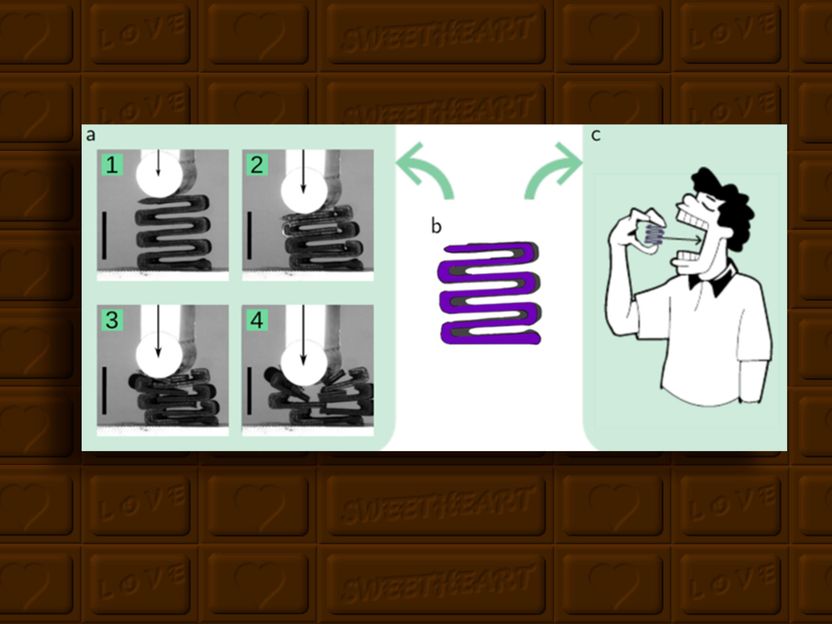Designing the perfect piece of chocolate
We like some foods, and dislike others. Of course, the way food tastes is important, but mouthfeel, and even the sound that food makes when we bite it, also determine whether we enjoy the eating experience. Is it possible to design edible materials that optimize this enjoyment? Physicists and food researchers show that indeed it is.

Designing mouthfeel
UvA IoP
In research that was published in Soft Matter this week, researchers from the University of Amsterdam, Delft University, and Unilever, demonstrate that the mouthfeel of an edible substance can be designed, just like properties of many other materials can. That is: they create metamaterials, materials that are not found in nature but that are carefully constructed in the lab. Their building material of choice is not wood, concrete or glass – they build their materials from chocolate.
Designing mouthfeel
As both professional and amateur bakers know very well, chocolate is not an easy material to work with. Simply heating it up and cooling it down can turn soft chocolate into much more brittle tempered chocolate, or vice versa. Therefore, the first challenge for the researchers was to get their building material under control. They did this by very carefully heating it up, adding some cold chocolate, cooling it down again… and then putting it in a 3D printer. This allowed them to print essentially any shape of chocolate material they wanted, while guaranteeing that the base material always had the same properties.
The first shape of edible material that the scientists experimented with was an S-shaped chocolate with many twists, as in the figure above. The goal was to test how this material would break and how that breaking would be experienced in the mouth. Not surprisingly, the breaking properties depended strongly on the direction of ‘biting’. When the chocolate was pressed from above, many different cracks occurred one after another, but when pressed in the direction perpendicular to the picture, usually only a single crack occurred. This was tested mechanically, as in the picture to the left, but also by feeding the chocolates to a panel of 10 – very willing – test persons. Both the mechanical tests and the test panel confirmed moreover that the ease of bite was better in the direction shown in the picture.
The more cracks, the better
Most people enjoy the experience of food crackling down in their mouths – the more cracks, the better. Having shown that such an experience can be designed, the researchers now tried some different structures, searching for a structure where the number of cracks can be ‘programmed’ into the material.
It turned out that spiral-shaped chocolate metamaterials like the ones displayed above have quite interesting and tunable properties. Not only does the number of windings directly control the number of cracks when the material is pressed mechanically; the test panel could also clearly distinguish between less and more cracks when eating the chocolates. Moreover, sound recordings showed that the sound the chocolates makes when being bitten reflects the number of cracks, adding to an enjoyable eating experience.
The perfect piece of chocolate
The final question was of course: is designing an enjoyable eating experience a matter of trial and error, or can nice edible materials actually be designed and finetuned before creating them? The researchers found that with a well-chosen mathematical model, they can indeed optimize certain shapes of chocolates with respect to, for example, their resistance to break when bitten from certain directions. Some of the resulting optimal shapes (for different bite strengths) can be seen below.
The design of edible metamaterials had not been studied before. The new research opens the door to ways to design foods that are enjoyable to eat – and more generally, to design materials that optimize the interaction between humans and matter.
Most read news
Organizations
Other news from the department science

Get the food & beverage industry in your inbox
By submitting this form you agree that LUMITOS AG will send you the newsletter(s) selected above by email. Your data will not be passed on to third parties. Your data will be stored and processed in accordance with our data protection regulations. LUMITOS may contact you by email for the purpose of advertising or market and opinion surveys. You can revoke your consent at any time without giving reasons to LUMITOS AG, Ernst-Augustin-Str. 2, 12489 Berlin, Germany or by e-mail at revoke@lumitos.com with effect for the future. In addition, each email contains a link to unsubscribe from the corresponding newsletter.




























































